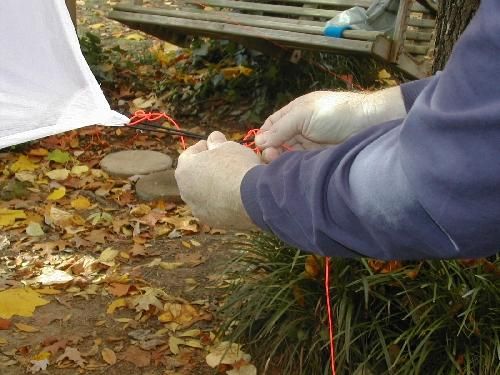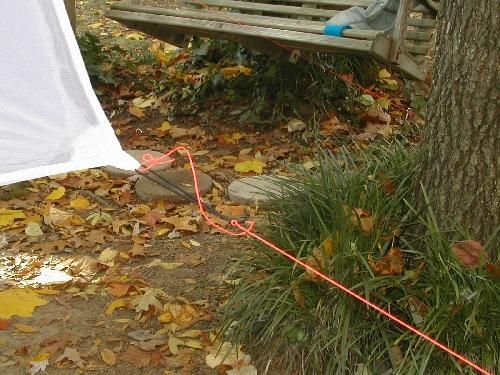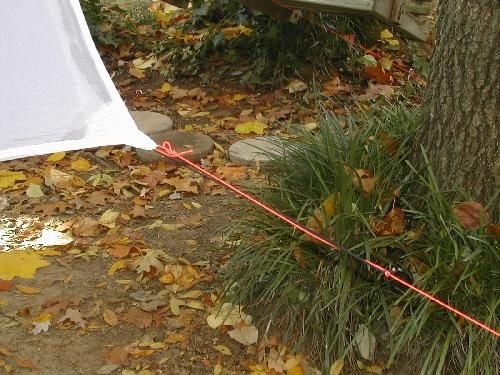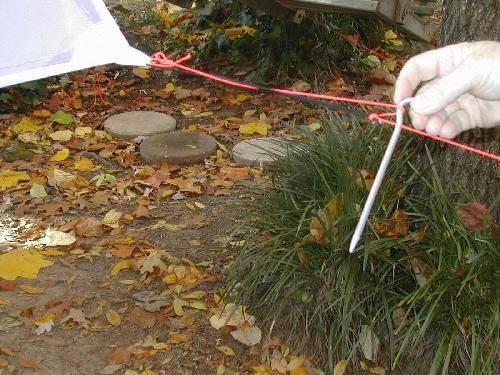Note: The following instructions for making shock cord tarp tensioners were originally posted on the Yahoo Hammock Camping Group by Youngblood. I am posting them in a thread for the benefit of the members of the forum, with Youngblood's permission.
Self Tensioning Guylines Made by Attaching Shock Cord to Tarp Guylines
Using small diameter shock cord tied in parallel with guyline for a tarp is easy to do and helps keep silnylon tarps taut when they stretch. I prefer to attach either 3/32 inch or 1/8 inch diameter shock cord that stretches slightly more than 100%. You need a reasonable balance of tension and stretch and these directions are for shock cord that stretches slightly more than 100%. You can tell how much shock cord stretches by grabbing 5 inches worth and seeing if it stretches to a little over 10 inches (100% stretch) or if it stretches to 15 inches (200%) or more.
I start out tying my guyline to the tarp pullout using a non-cinching knot like an overhand knot or a bowline. A non-cinching knot will give you a loop to locate a stake very close to the tarp when you want to pitch the tarp with that tie-out very close to the ground. At this point I mark where 12 inches from the tie-out is located on the guyline as shown in Figure 1.
Figure 1. Marking 12 Inches on the Guyline.
Next I insert a 12 inch piece of shock cord into the tie-out such that it is doubled over and 6 inches long with two tails as shown in Figure 2. There is no knot used to tie the ends of the shock cord together at this point, that will be taken care of in a following step when the shock cord is attached to the guyline with a clove hitch knot.
Figure 2. Insert the Shock cord Through the Tie-out.
Now, we from a clove hitch knot at the 12 inch mark on the guyline, preferably using the two loop method, where you form two identical loops then place the second one underneath the first one as shown in Figure 3.
Figure 3. Form a Clove Hitch Knot.
The two ends of the shock cord are inserted in the loops of the clove hitch as shown in Figure 4
Figure 4. Inserting the Two Ends of the Shock Cord into the Loops of the Clove Hitch Knot.
Finish the clove hitch knot by cinching it on the two tails of the shock cord leaving approximately 1/2 inch tails as shown in Figure 5.
Figure 5. Finished Clove Hitch Knot Attaching Shock Cord to Guyline.
At this point, I attach my stake with a clove hitch to the guyline where I want the stake located for the particular pitch I am using with my tarp. When this self tensioning guyline is initially pulled taut, it looks like Figure 6. In the morning that same line may look more like Figure 5 if it has taken up a lot of tarp stretch.
Figure 6. FullyTaut Self Tensioned Guyline.
This technique gives you visual indication of how much stretch the self tensioning guylines are taking out of the tarp and gives you two easy to use stake-out locations when you are pitching your tarp close to the ground, as shown in Figures 7 and 8. Of those two techniques, Figure 8 locates the tarp closer to the ground but does not use the shock cords to take up any stretch in the tarp.
Figure 7. Using the Shock cord as a Stake Location.
Figure 8. Using the Non-cinching Loop on the Guyline for a Stake Location.
It should be noted that self tensioning guylines used with stakes is a loaded sling shot with a sharp projectile. Be careful and hold on to the stake when the self tensioning guyline is tensioned. I use stakes that have smooth round shafts and attach the stake to the guyline using a clove hitch because it is easy to tie with the two overlapping loop technique and the clove hitch knot will simply fall out when I slide it down and off the shaft of the smooth round stake. They also stay attached to the guyline until I slide them off; I personally feel it is safer that way. Be careful and set your stake firmly in the ground so that it doesn’t have a tendency to pull free and launch itself with the self tensioned guylines. The 3/32 inch and 1/8 inch shock cord isn’t particularly strong and you don’t have a long throw with the doubled over 12 inch piece so it shouldn’t be an accident waiting for a place to happen if you take reasonable precautions. I have done this without accident and without losing a stake for many years but I have heard of stakes being launched and lost as well as tarps torn and people getting minor injures from stakes attached to shock cord striking an arm or hand.
One should be particularly careful when removing tensioned stakes from the ground as they want to shoot towards the tarp like a sling shot and if you are bent down where your face is in range of the sling shot you are putting yourself in a bad position. That is probably your most vulnerable time, removing a tensioned stake from the ground. I try to keep one hand on the stake, one hand on the free end of the guyline, and stand on the safe side of the stake when I remove them… you are on the safe side when the stake is between you and the tarp. Always remember that the sling shot is pointed towards the tarp and it can’t get you if you keep the stake between you and the tarp. I keep that in mind and practice that religiously whether I am inserting a tensioned stake into the ground or removing it from the ground… you need to respect them as they can jump out and get you. If you are not comfortable dealing with tensioned guylines attached to a stake, you should not use them…you don’t have to have tensioned stakes to use tarps, they simply have some advantages in that they help keep a tarp taut without readjustments and less likely to droop, flap or get damaged in high winds.
(Both the 1/16 inch diameter guyline and 3/32 inch diameter shockcord used in these instructions can be purchased from Speer Hammocks at www.speerhammock.com . )
December 7, 2007















 Reply With Quote
Reply With Quote

Bookmarks